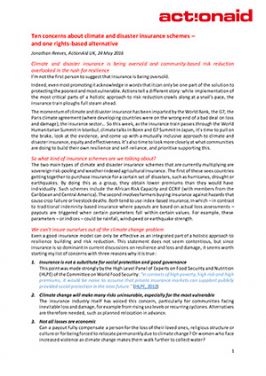Ten concerns about climate and disaster insurance schemes – and one rights-based alternative
Climate and disaster insurance is being oversold and community-based risk reduction overlooked in the rush for resilience.
Executive summary
The two main types of climate and disaster insurance schemes that are currently multiplying are sovereign risk-pooling and weather-indexed agricultural insurance. The first of these sees countries getting together to purchase insurance for a certain set of disasters, such as hurricanes, drought or earthquakes. By doing this as a group, they obtain lower premiums than they would have individually. Such schemes include the African Risk Capacity and CCRIF (with members from the Caribbean and Central America). The second involves farmers buying insurance against hazards that cause crop failure or livestock deaths. Both tend to use index-based insurance, in which – in contrast to traditional indemnity-based insurance where payouts are based on actual loss assessments – payouts are triggered when certain parameters fall within certain values. For example, these parameters – or indices – could be rainfall, windspeed or earthquake strength.
